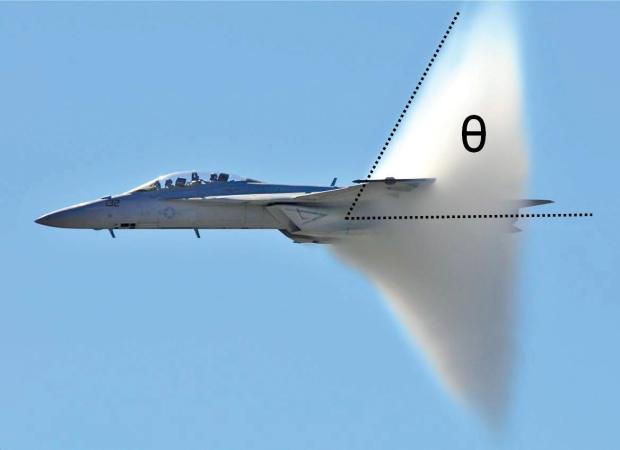Under ideal circumstances, sound or light waves emitted from a point source propagate in a spherical fashion from the source. As the distance to the source grows, the energy of the waves is spread over a larger area and thus the perceived intensity decreases. We’ll take a look at the formula that allows us to compute the intensity at any distance from a source.
First of all, what do we mean by intensity? The intensity I tells us how much energy we receive from the source per second and per square meter. Accordingly, it is measured in the unit J per s and m² or simply W/m². To calculate it properly we need the power of the source P (in W) and the distance r (in m) to it.
I = P / (4 · π · r²)
This is one of these formulas that can quickly get you hooked on physics. It’s simple and extremely useful. In a later section you will meet the denominator again. It is the expression for the surface area of a sphere with radius r.
Before we go to the examples, let’s take a look at a special intensity scale that is often used in acoustics. Instead of expressing the sound intensity in the common physical unit W/m², we convert it to its decibel value dB using this formula:
dB ≈ 120 + 4.34 · ln(I)
with ln being the natural logarithm. For example, a sound intensity of I = 0.00001 W/m² (busy traffic) translates into 70 dB. This conversion is done to avoid dealing with very small or large numbers. Here are some typical values to keep in mind:
0 dB → Threshold of Hearing
20 dB → Whispering
60 dB → Normal Conversation
80 dB → Vacuum Cleaner
110 dB → Front Row at Rock Concert
130 dB → Threshold of Pain
160 dB → Bursting Eardrums
No onto the examples.
———————-
We just bought a P = 300 W speaker and want to try it out at maximal power. To get the full dose, we sit at a distance of only r = 1 m. Is that a bad idea? To find out, let’s calculate the intensity at this distance and the matching decibel value.
I = 300 W / (4 · π · (1 m)²) ≈ 23.9 W/m²
dB ≈ 120 + 4.34 · ln(23.9) ≈ 134 dB
This is already past the threshold of pain, so yes, it is a bad idea. But on the bright side, there’s no danger of the eardrums bursting. So it shouldn’t be dangerous to your health as long as you’re not exposed to this intensity for a longer period of time.
As a side note: the speaker is of course no point source, so all these values are just estimates founded on the idea that as long as you’re not too close to a source, it can be regarded as a point source in good approximation. The more the source resembles a point source and the farther you’re from it, the better the estimates computed using the formula will be.
———————-
Let’s reverse the situation from the previous example. Again we assume a distance of r = 1 m from the speaker. At what power P would our eardrums burst? Have a guess before reading on.
As we can see from the table, this happens at 160 dB. To be able to use the intensity formula, we need to know the corresponding intensity in the common physical quantity W/m². We can find that out using this equation:
160 ≈ 120 + 4.34 · ln(I)
We’ll subtract 120 from both sides and divide by 4.34:
40 ≈ 4.34 · ln(I)
9.22 ≈ ln(I)
The inverse of the natural logarithm ln is Euler’s number e. In other words: e to the power of ln(I) is just I. So in order to get rid of the natural logarithm in this equation, we’ll just use Euler’s number as the basis on both sides:
e^9.22 ≈ e^ln(I)
10,100 ≈ I
Thus, 160 dB correspond to I = 10,100 W/m². At this intensity eardrums will burst. Now we can answer the question of which amount of power P will do that, given that we are only r = 1 m from the sound source. We insert the values into the intensity formula and solve for P:
10,100 = P / (4 · π · 1²)
10,100 = 0.08 · P
P ≈ 126,000 W
So don’t worry about ever bursting your eardrums with a speaker or a set of speakers. Not even the powerful sound systems at rock concerts could accomplish this.
———————-
This was an excerpt from the ebook “Great Formulas Explained – Physics, Mathematics, Economics”, released yesterday and available here: http://www.amazon.com/dp/B00G807Y00.





